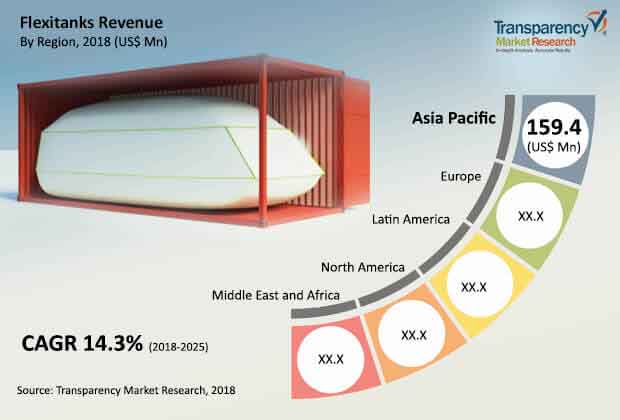
Flexitanks Market – Snapshot
Flexitanks are bags used to transport large quantities of liquids upto 24,000 liters, in a 20- feet container. They are manufactured in standard sizes, ranging from 10,000 liters to 24,000 liters. They are bags of polymer materials such as polyethylene, polypropylene, PVC coated fabric, etc. usually employed for transportation of non-hazardous liquids such as wine, fruit juices, edible oils, industrial liquids, sweeteners, agricultural liquids, etc. All the liquids that do not fall under the category of dangerous goods as per IMDG code can be transported using flexitanks. Currently, flexitanks are employed for transport of edible liquids such as wine, fruit juices, edible oils, sweeteners, etc. Around 30% of the wine all over the world is transported using flexitanks. Flexitanks are of three types: monolayer, bi-layer, and multilayer. Multilayer flexitanks are the most preferred type owing to their low cost and several advantages. The flexitanks market is anticipated to offer significant potential, especially in the Asia Pacific region. Asia Pacific is one of the leading exporters of liquids such as vegetable oils, aerated & non-aerated beverages, water, industrial and agricultural liquids, etc. due to which Asia Pacific accounted for a major share of the flexitanks market in 2017.

Low Overall Cost of Flexitanks Compared to that of Other Bulk Packaging Products
The average cost of a flexitank is much higher than the per unit cost of intermediate bulk container IBCs or drums. However, in case of transport of large quantities of liquids, the overall cost of flexitanks, including operational cost, proves to be more economical than that of its counterparts.
Request Brochure @
https://www.transparencymarketresearch.com/sample/sample.php?flag=B&rep_id=2570
A standard 20-feet container is usually chosen to transport bulk quantities of liquids. The 20-feet container accommodates one flexitank with the capacity of 24000 liters. It requires around 18 units to 20 units of IBC tanks and 80 units of drums to transport an equivalent or lesser quantity of liquid in a 20-feet container. The quantity of cargo/liquid that can be transported decreases marginally in IBCs and drums due to the large number of units. The per unit cost of ISO tanks is high. It ranges from around US$ 15,000 to US$ 16,000. Often, ISO tanks are procured on a rental basis, wherein the per day rent of these tanks ranges between US$ 15 and US$ 20. This proves to be high for longer duration journeys. Furthermore, the user has to bear an additional return cost for getting the empty ISO tanks back to the destination. Thus, the overall cost of flexitanks proves to be 30% to 40% lesser compared to that of other bulk packaging products.
REQUEST FOR COVID19 IMPACT ANALYSIS –
https://www.transparencymarketresearch.com/sample/sample.php?flag=covid19&rep_id=2570
Risk of Cargo Loss due to Leakage
Risk of leakage of cargo in flexitanks is higher than that in other bulk packaging carriers. Flexitanks are made up of polyethylene or polypropylene. Chances of damage to the flexitank material are high due to improper or careless handling during loading/unloading. Therefore, utmost care has to be taken while loading and discharging flexitanks in and from containers. These operations can be conducted by operators that provide fitting services of flexitanks into containers. These can also be carried out by flexitank manufacturers with technical expertise and knowhow. Flexitanks are useful in transportation of bulk quantities of products. Hence, they appeal only to users transporting bulk quantities of cargo/liquid. Flexitanks are not feasible for small players transporting less quantities of liquids. An entire quantity of a liquid is stored in a flexitank. Therefore, chances of losing the entire quantity of liquid during a case of contamination is high. This can lead to significant losses.
Increase in Contribution of Developing Regions/Countries in Global Trade
The global trade of edible liquids such as wine, fruit juices, sweeteners, edible oils, potable water, and aerated and non-aerated beverages has increased significantly in the last few years. Developing countries such as Brazil, Indonesia, Thailand, Chile, Argentina, China, India, and South Africa account for a major share of the trade. In case of wine and fruit juices, countries in Latin America and Europe are among the major exporters. Countries in Southeast Asia such as Indonesia, Thailand, and Malaysia hold significant share in terms of trade of edible oils. Brazil, China, and India are also among the major exporters of edible oil. China is one of the key exporters of water for drinking and usage in aerated and non-aerated drinks. Furthermore, the global trade of non-hazardous chemicals such as inks, paints, emulsifiers, latex, fertilizers, and detergents has also been rising since the last few years. Countries in Asia Pacific such as China and India and ASEAN are witnessing rapid industrial expansion. Thus, Asia Pacific also constitutes a prominent share in terms of export of products. Flexitanks prove to be highly economical and useful in case of export of bulk quantities of liquids. This offers lucrative opportunities for flexitank manufacturers in developing regions such as Asia Pacific, Latin America, and South Africa.
Production Capacity Expansion by Flexitank Manufacturers
In 2018, Qingdao Hengxin Plastic increased its flexitanks production capacity to 200,000 units. The company has been manufacturing flexitanks for more than a decade. It sold around 100,000 units of flexitanks in 2017. In June 2017, Environmental Packaging Technologies (EPT) began expansion of its manufacturing facility in Zeeland, Michigan, the U.S. due to increased customer demand.
In April 2016, Rishi FIBC Pvt. Ltd. expanded by developing a 180,000 sq. ft., full-fledged campus for production of flexitanks along with along bulk packaging products in Mysore, Karnataka, India.
Multilayer Flexitanks, Single-use flexitanks, Polyethylene, and Food Grade Liquids Anticipated to be Dominant Segments During the Forecast Period
In terms of product, multilayer flexitanks have gained a significant portion of the flexitanks market share in the past few years and the trend is likely to continue during the forecast period. Multilayer flexitanks are made up of several layers of polyethylene, covered with an outer protective layer of polypropylene. The layers make the flexitanks secure to carry huge quantities of liquids. Single-use flexitanks are highly preferred these days by users as they eliminate the extra effort of cleaning when using reusable flexitanks. Polyethylene holds a major share, by weight, in the overall construction of a multilayer flexitank. LLDPE is a type of polyethylene that is significantly employed for manufacturing polyethylene layers. Flexitanks are employed to transport edible liquids such as vegetable oils, fruit juices, wine etc. Food grade liquids segment held a major share of the flexitanks market in 2017.
Asia Pacific Held a Major Share of Global Flexitanks Market in 2017
Regions such as Asia Pacific are experiencing major economic and infrastructural development in developing countries such as China, India, Vietnam, and Indonesia etc. Moreover, the region plays a major role in the global trade of edible liquids such as vegetable oils, aerated beverages, water, etc. Asia Pacific accounts for a major portion of global trade. Therefore, Asia accounts for a significant market share of the global flexitanks market. Asia Pacific is followed by Europe, which is among the major producers and exporters of wine.
Moderately Consolidated Market for Flexitanks with the Top Few Players Accounting for More Than 50% of the Market
The global flexitanks market is a moderately consolidated market, with top players accounting for more than 50% of market share. Key players in the flexitanks market are Trans Ocean Bulk Logistics Ltd., Braid Logistics UK, Trust Flexitanks, and Qingdao Global Flexitank Logistics etc.





